Garlic plants have been one of the most popular and beneficial vegetables that take about 9 months to grow. To have a successful garlic growth in your garden, you must understand its watering needs.
Garlic plants need to be watered thoroughly every 3-5 days for consistent moist soil. If garlic is getting full sun, water them enough so the soil doesn’t get dry. You can skip the watering if it rains and the soil is already moist. Also, avoid watering the plant in the winters.
If you wish to know every detail about the garlic plant’s water requirements, read this article till the end.
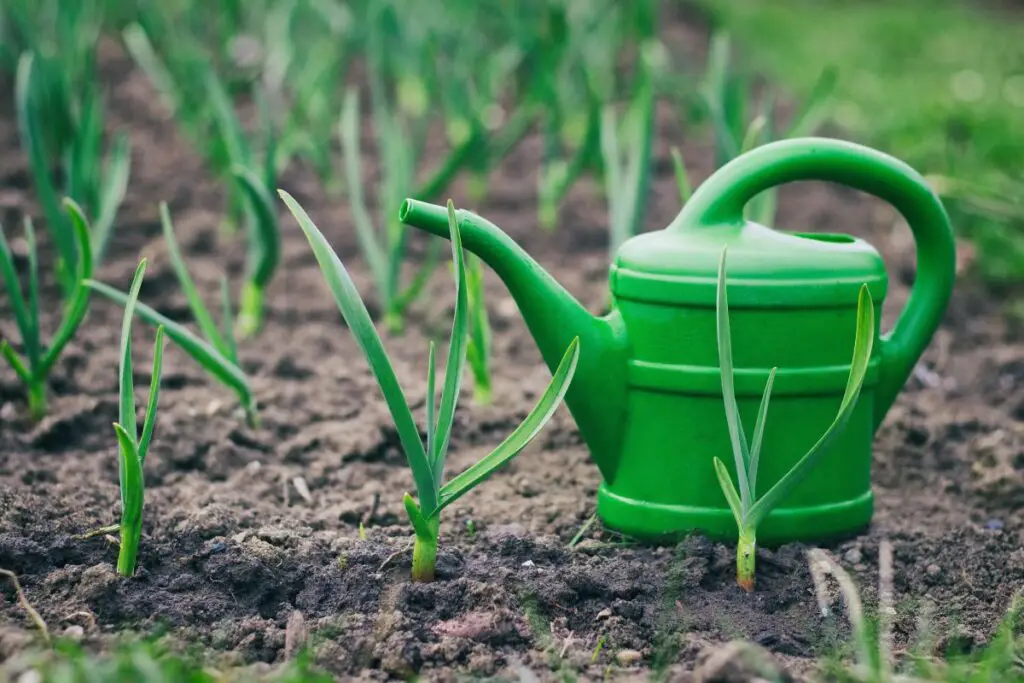
Does scheduled watering work for garlic?
A strict, scheduled watering never works for any plant because the watering frequency changes depending on many factors.
Your garlic plants will undergo various problems if you don’t change the watering routine according to the situation.
Following a regular watering routine in winter will cause overwatering and rotting.
On the contrary, following a winter-like schedule during the spring and summer will cause dehydration and affect garlic’s growth and development.
Instead of following a routine, you can check the soil’s moisture level of the top few inches with a moisture meter and then water it.
Garlic watering needs and frequency
Depending on the soil and season, you should water the garlic plants every 3 days.
Growing garlic plants in tropical climates will dry out the soil faster.
In that case, you have to water the plant more often.
While growing garlic in pots, add water until you notice the excess water draining from the drainage holes.
When you opt for the next watering, the top 1-inch of the soil should be dry.
If it is sticky, then wait for some more days to water the plant.
To understand the correct watering frequency, you should understand the temperature, soil type, precipitation, and season.
Watering after planting
When fall arrives, plant garlic in your garden by making a hole, putting the clove in it, and covering it with the soil.
Ensure that the soil you are planting garlic plants in is well-drained.
Now, water the soil or raised bed with a sprinkler and moisten the soil enough.
Autumn is the season of rain.
If your area receives frequent rains, you don’t have to water the plants in the first period.
If you feel that the soil is dry, water them very lightly after planting.
If there is no rain for 7-10 days and the soil is dry, you have to water the plant to moisten the soil well.
After germination
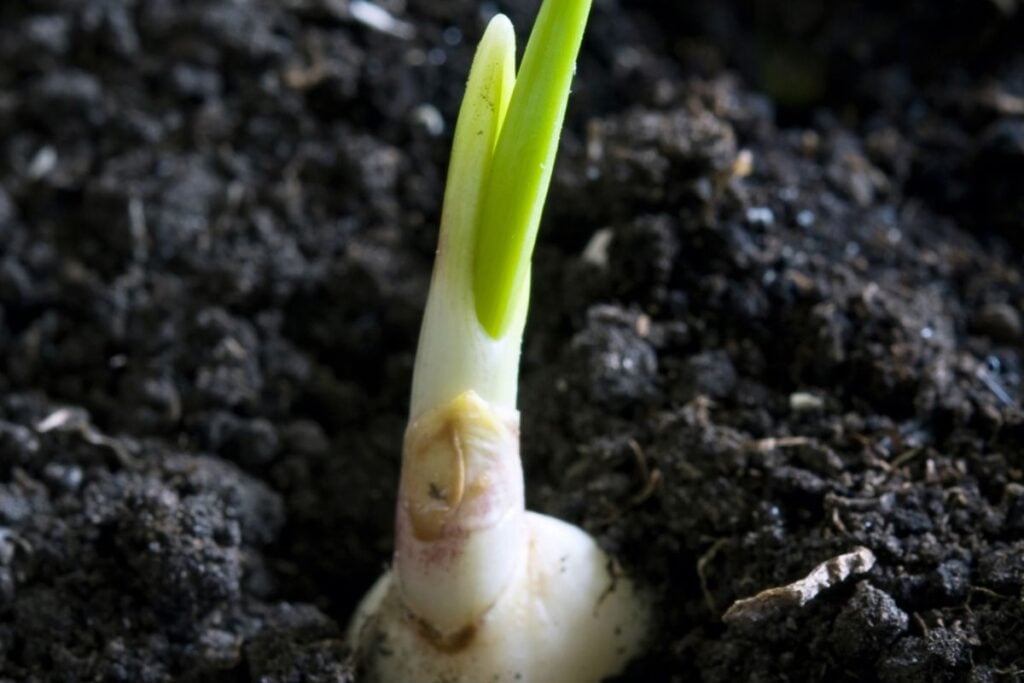
You must keep the soil moist most of the time but not soggy.
Check the top 1-inch of the soil with your finger.
If it is moist, then don’t water it.
But if it’s dry, water the plant well.
Don’t let the soil dry too much.
Otherwise, the bulbs will become smaller, and the plant won’t grow well.
Before harvesting
The right time to harvest garlic depends on the climate.
In general, garlic is ready to harvest when the leaves at the plant’s base will start to dry out.
It would be best to stop watering the garlic plants 2 to 4 weeks before the established harvesting date.
If rain arrives, wait for the soil to dry out before digging out their heads.
Looking for gardening supplies? We have tested 100's of products before recommending them to you guys. Check out our best pick below:
| Image | Gardening Supplies | Best Price? |
|---|---|---|
 Top
Top Top
Top | Raised Garden Bed Kit | Check On Amazon |
 | XLUX Soil Moisture Meter, Plant Water Monitor, Soil Hygrometer Sensor for Gardening, Farming, Indoor and Outdoor Plants, No Batteries Required | No Results |
 Top
Top Top
Top | 82 Pcs Garden Tools Set and Extra Succulent Tools Set | Check On Amazon |
 | Joeys Garden Expandable Garden Hose with 8 Function Hose Nozzle, Lightweight Anti-Kink Flexible Garden Hoses, Extra Strength Fabric with Double Latex Core, (50 FT, Black) | No Results |
 Top
Top Top
Top | Dual Chamber Compost Tumbler | Check On Amazon |
 Top
Top Top
Top | Sunnyglade Plant Stakes | Check On Amazon |
 Top
Top Top
Top | Organic Cold Pressed Neem Seed Oil | Check On Amazon |
 Top
Top Top
Top | Mighty Mint Gallon :-Insect and Pest Control Peppermint Oil | Check On Amazon |
 Top
Top Top
Top | Scotts DiseaseEx Lawn Fungicide | Check On Amazon |
 Top
Top Top
Top | Jacks Classic 20-20-20 All Purpose Fertilizer | Check On Amazon |
 Top
Top Top
Top | 30,000 Seeds Pollinator Attracting Wildflower Mixture | Check On Amazon |
 Top
Top Top
Top | Survival Vegetable Seeds Garden Kit-Over 16,000 Seeds | Check On Amazon |
Winter watering
You don’t have to water the garlic plants during the winter because garlic remains dormant when the ground is frozen.
When the temperature drops, add a layer of mulch around the plant.
Mulching will help to preserve the moisture in the soil bed.
At the same time, you do not have to fertilize them.
Since garlic remains dormant, the plant won’t uptake extra nutrients.
Spring watering
When spring arrives, the temperature rises and garlic plants will start growing.
So, you have to start with little watering once winter ends and spring arrives.
When you find the heads develop in the spring, water the garlic plants once every 3-5 days.
Don’t let the soil dry out.
To understand how deep the water has gone, use a moisture meter.
Summer watering
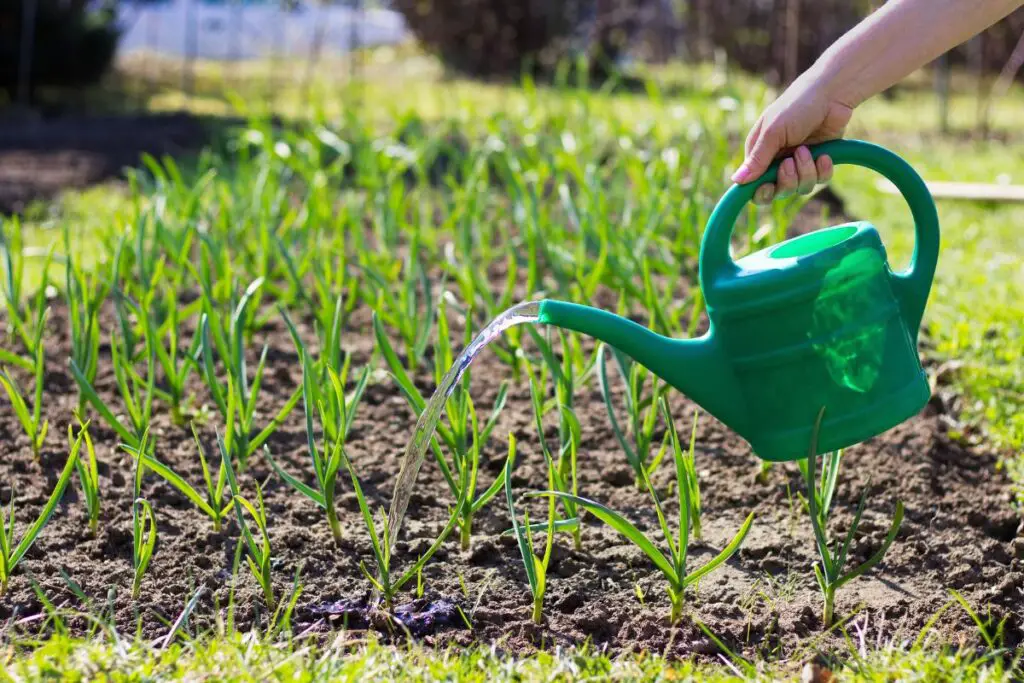
The sun’s heat is too scorching during the summer, and the garlic plants remain under the sunlight.
As a result, the soil will become dry very often.
So, you have to increase the watering frequency, in that case, to keep the soil moist.
Though the plant will not suffer from sun exposure, increased watering keeps the soil moist.
Prolonged dryness can reduce the bulb size and affect garlic’s good development.
You can check the soil moisture now and then to determine the moisture level and water it.
The top 1-2 inches should be moist.
Do garlic plants need a lot of water?
While watering garlic plants, you need to water them enough to keep the topsoil moist so that they don’t dry out.
At least about 50% of the soil should remain moist most of the time.
Garlic has a very shallow root system.
The bulbs have around 50 fine roots, which can develop around one foot in length.
So, you have to water the plant generously to moisten the soil and those deep roots.
But make sure not to pour lots of water.
Excessive water accumulating around the roots can suffocate them and result in overwatering.
Factors determining the watering frequency of garlic plants
Many factors determine the frequency of garlic plants:
- Light
- Soil
- Temperature
- Container
Let’s understand how these factors impact the water requirement of garlic plants.
Light
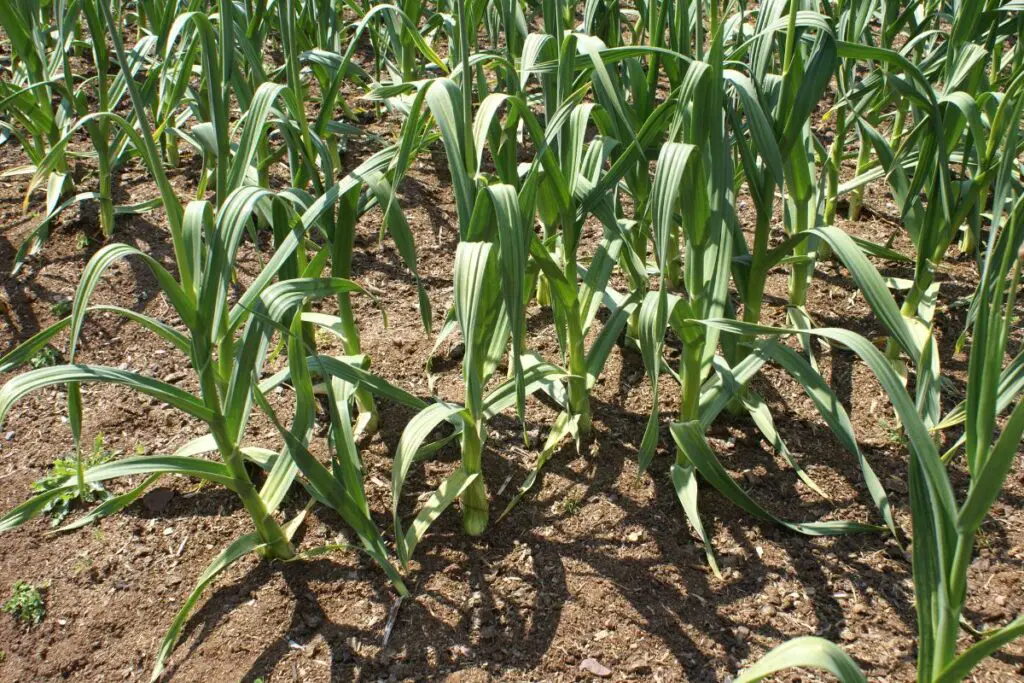
As a rule of thumb, garlic plants need 6-8 hours of sunlight per day.
Some need only 4 hours of sunlight.
The more sunlight a plant receives, the faster the moisture dries out from the soil.
If your garlic plants are getting too much sunlight for a long time, the soil will dry out faster than the normal rate.
It would be best to increase the watering frequency.
But if the plant is not getting enough sunlight, the soil takes time to dry out.
You can water the plants less often.
But also make sure the water is well-drained to prevent overwatering.
Besides the soil drying out fast, more light makes the plant more active, especially in photosynthesis.
So, to function well, the plant will need more water.
If it fails to get enough water, the bulbs will get affected, and the garlic will not develop well.
So, give the plant enough water.
Soil type
The type of soil you use for your garlic plants can also influence the watering time and frequency.
Soil, like clay, retains water for a long time, and some soil, like sandy, cannot hold it for long.
The former can cause overwatering and the latter, underwatering.
Though garlic can grow in a wide range of soil types, it is best to use one that balances drainage and retention and has good organic matter.
If the soil is clayey, water less often.
If it’s sandy, water more often.
For best results, grow garlic in raised beds.
Add compost to increase the soil quality.
Temperature
The temperature of your region also determines the frequency.
If you belong to the tropical climatic regions, the weather will be warmer and dryer than in the other zones.
As a result, the soil can dry out faster.
In that case, you have to water the plant more often.
When the climate becomes cold, garlic will become dormant.
So, you don’t have to water the plants in winter.
But to hold on to the moisture in the soil, add a layer of mulch around the plant.
Container
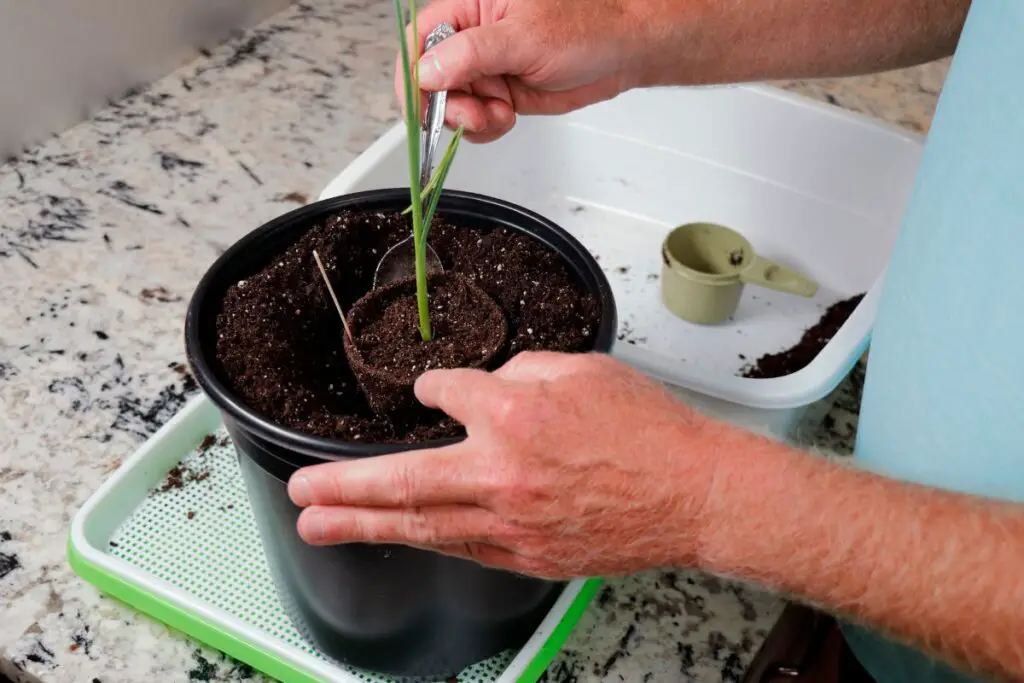
Though garlic plants are mostly grown on the grounds and in raised beds, that doesn’t mean you cannot grow them in containers.
You can still grow them in pots and still keep them outside.
You have to water them more often if you use terracotta pots because they are very porous.
However, terracotta pots are not good for garlic.
If you use plastic, fiberstone, or plasti-stone, you can follow the usual watering routine.
Sometimes, you can also water less often since these pots can hold moisture for some time.
How much water does garlic plant need?
Garlic plants will require only 1 inch of water every week if they are planted over clayey or loamy soil.
Since these soils have high retention qualities, 1-inch of water is enough for the whole week during the growing months.
On the contrary, give the garlic plants 2 inches of water if they grow over sandy soils during the growing months.
Sandy soils have faster-draining qualities.
That is why they need frequent watering and more quantities of water.
What happens if you overwater the garlic plants?
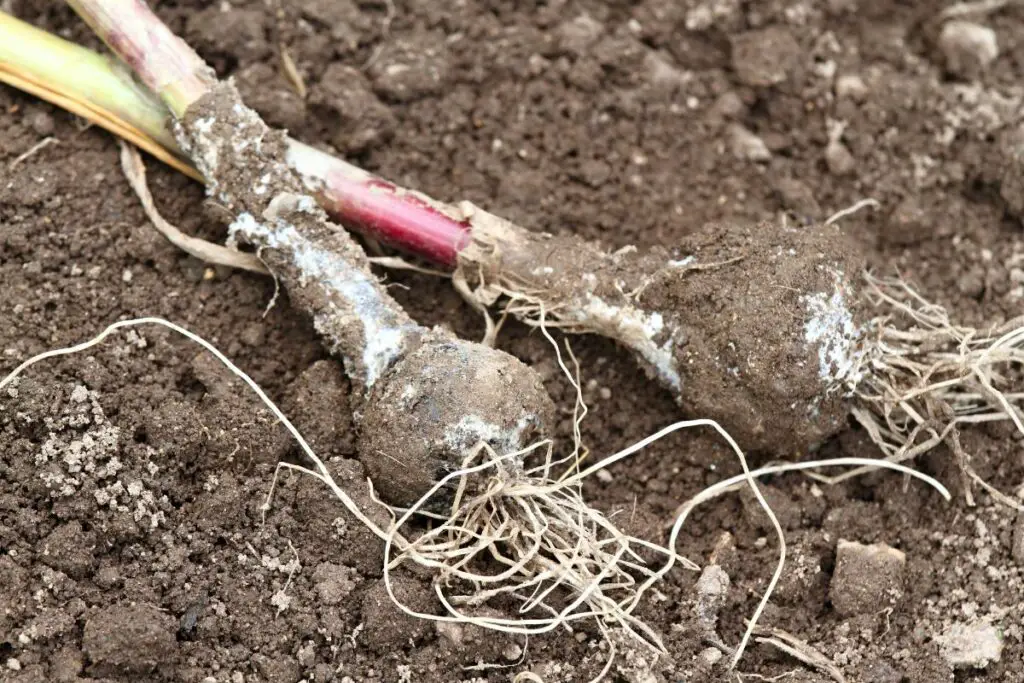
If you are a beginner, it is possible and common to overwater the garlic plants.
Beginners think that giving more water can help the plant grow faster.
But that’s not the truth.
Excessive watering accumulates a lot of water around the roots and causes overwatering and rotting.
It happens due to repeated watering and when the garlic plants grow over clayey soils.
Clayey soils will drain very slowly.
Over that, if you continue the usual watering without checking the moisture level, it can cause overwatering.
Excessive water suffocates the roots and rots them.
This further causes:
- White rot
- Pink root
- Basal root
- Yellow leaves
- Stunted growth
How to fix overwatering?
If you have an overwatered garlic plant, follow these steps:
- Stop watering the plant and check the roots.
- Let the top 1-2 inches of the soil dry before watering.
- Transplant your garlic plant if the soil is too clayey.
- If your soil is mulched, remove some of them to let the soil dry.
- If your garlic is under low light conditions, transplant it to a sunny location.
- Make sure the soil is well-drained.
- Use raised beds to control the watering.
What happens if you underwater garlic plants?
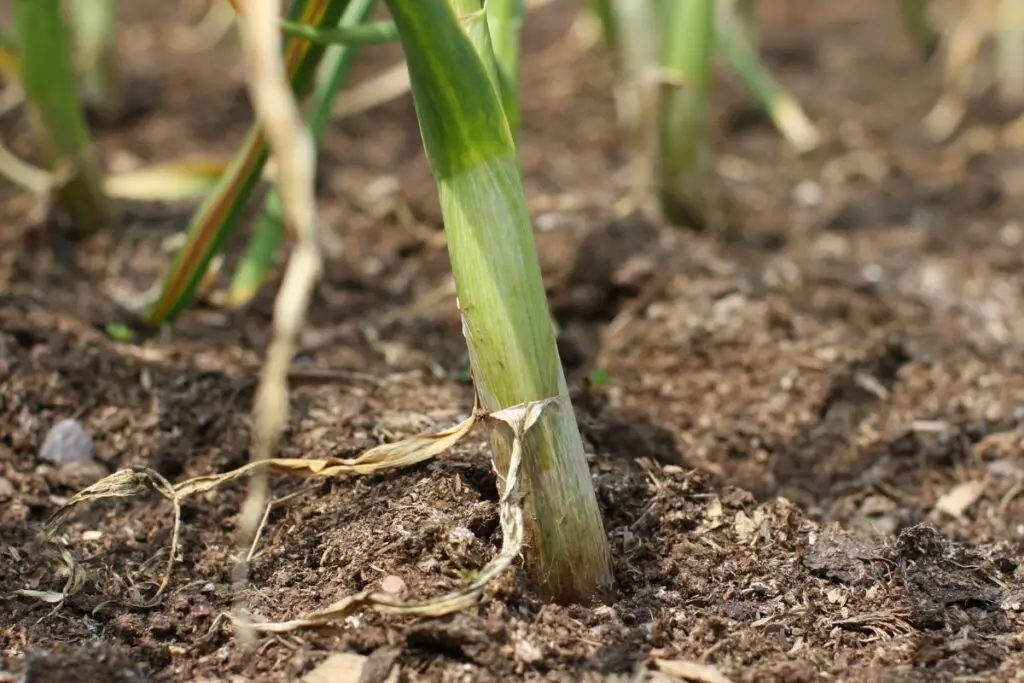
Garlic plants will not respond well to dry soil.
Dehydration will:
- Make the bulbs smaller
- The heads will not grow out or stop growing.
- The plant’s overall growth and development will be affected.
- The leaves will become yellow and limp.
When you don’t water the plant enough, especially during the spring and summer, the soil dries faster and remains dehydrated for a long time.
Another culprit is soil. Sandy soil doesn’t hold water for a long time.
It not only causes underwatering but also causes under-fertilization due to the soil’s poor retention qualities.
How to fix it?
Fixing an underwatered garlic plant will be easier than dealing with an overwatered one.
- If you find signs of underwatering, consider checking the soil.
- Water the plant deeply if you have not watered it for a long time.
- Make sure that the soil is both well-drained and loamy. It must have a balance between retention and drainage.
- Adding compost can help improve soil structure, quality, and even retention.
What is the best way to water garlic plants?
When you water the garlic plants, the water should reach the roots, which can grow quite deep, around one foot.
The soil must remain moist and not wet, especially for the first few months.
Before planting and watering, it is better to check the water permeability.
The best method of watering the garlic plants is drip irrigation, mainly for the heavy soils.
Over time, it improves water penetration and allows the water to reach the roots deep down.
Install drip irrigation before planting the garlic plants.
You can also water them from a watering can.
But, you have to create a shallow well to check the infiltration.
Final thoughts
Garlic prefers moist soil and not wet or soggy soil. Water the plants every 3-5 days in the spring. If there are rains, water them every 7-10 days. If the summer is too scorching, increase the frequency.
Stop watering during the winters and add a layer of mulch to conserve the moisture. Consider the seasons, temperature, and soil types before watering them.
Check the soil’s moisture level always before watering. Use a moisture meter or poke your finger 1-inch deep to feel the moisture. If you find any yellow or droopy leaves, check the soil and take steps.
Reference: The Pennsylvania State University, Garlic Production for the Gardener, University of Massachusetts Amherst, Ohio State University Extension.

Good explanation.
Thank you🙏